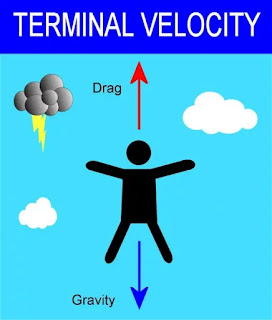TERMINAL VELOCITY
Everyone must have seen that when a stone and any other objects , fell down in the pond or a well and any other water bodies, then the speed of falling of stone in water has been changed and start falling with a constant velocity.

So, the question is , why velocity of stone has changed and acquired a different velocity?
Then the answer to this question is explained below:
According to the Archimedes principle , if any object is immersed fully or partially in the fluid then that object experiences a buoyant force and this buoyant force is equal to the weight of fluid which is displaced by the object at the time of immersing. Every object displaced the same amount of volume as the volume of the object.
It means when a stone is dropped into the water then the buoyant force start acting in the opposite direction of falling object.
But only Archimedes principle is not responsible for the attaining this constant velocity.
We know that only ideal fluid is non viscous, otherwise all fluids are viscous to some extent. And we know that viscosity is the property of the fluid, which comes due to the friction between the two laminae which opposes the relative velocity of each other. And due to this friction between the two laminae of fluid , a force is generated, and this force is called the force of viscosity, also called dragging force.
Which is derived by the George G. Stokes. Which is famous as STOKES LAW.
It means when a piece of stone is dropped into the fluid of viscosity η then each lamina or layer also opposes the velocity of the falling object. And force of viscosity is is directly proportional to the viscosity of the fluid , if fluid has higher viscosity then the force of viscosity will be also higher.
And higher viscous force then higher opposition.
So if any object is dropped into the fluid of viscosity η then it’s motion is hindered or opposed by the two forces that is buoyant force and viscous force. This both forces changed the velocity of falling object to the constant Velocity , and that constant velocity is called TERMINAL VELOCITY.
If we define terminal velocity formally then we can say that the maximum constant velocity acquired by the falling object in the viscous fluid called terminal velocity.
Now we are going to deriving the formula for terminal velocity.
DERIVATION FOR TERMINAL VELOCITY
Let’s take a spherical object of radius R and density ρ and density of fluid is σ and it’s viscosity is η. If object is in the fluid then volume is displaced is equal to the volume of the spherical object.
Volume of fluid displaced = (4/3)πR^3
Mass of fluid displaced = Vσ
Then weight of fluid displaced = Vσg
Putting all the values , we get; Weight of fluid displaced= (4/3)πR^3σg
And the force of viscosity is given as ;
Force of viscosity = 6πηRv
Then the weight of the object due to gravity is = Vρg = (4/3)πR^3ρg
In ideal condition
The Buoyant force and viscous force balance the weight of the object, then
6πηRv + (4/3)πR^3σg = (4/3)πR^3ρg
6πηRv = (4/3)πR^3(ρ – σ)g
Cancelling R and π both side we get the required terminal velocity as follows:
v = (2/9)R^2(ρ-σ)g/η
This velocity is acquired by the object when they start falling in the fluid.
Note: this formula depends on the shape, size and geometry of the object. If geometry change then formula is also changed. Because this formula depends on the fluid which displaced, but we know that cubicle object displaced different volume of fluid, conical , cylindrical, cuboidal also displaced different volume of fluid.
For this there are different different terminal velocities.
This terminal velocity is only for spherical objects.
